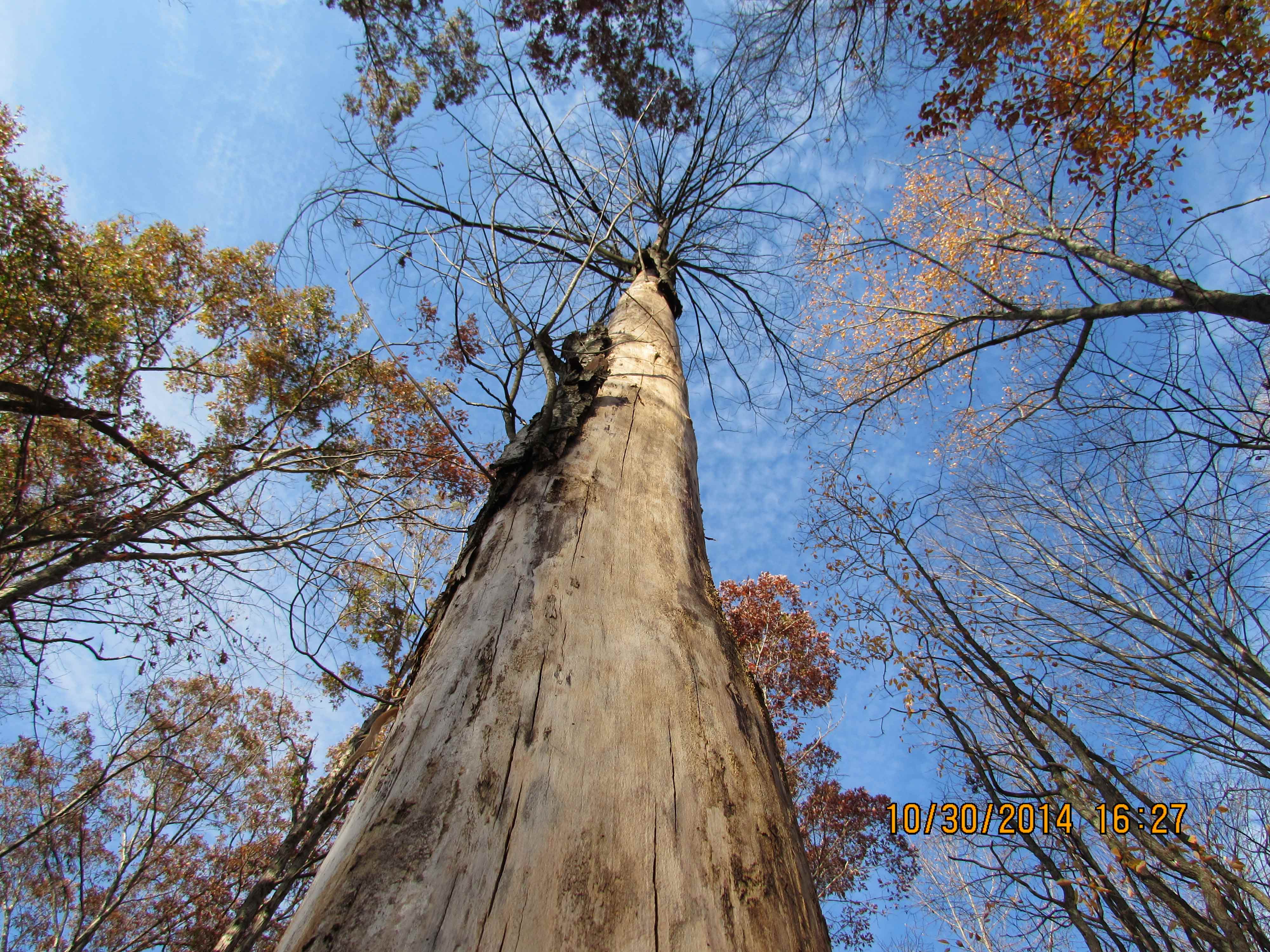Snags and Cavity Trees
Snags are a valuable component of the forest and play a vital role in the ecosystem. Snags are dead or dying trees, cavity trees are alive or dead trees with open cavities in them. Snags are created naturally in a forest and can range in size from a few inches in diameter to the very largest trees in a woodland. All snags serve a purpose, but larger snags tend to provide more benefits over a longer period. Cavities in live trees occur naturally from broken limbs, defects or damage to a tree. Certain animal species enhance natural cavities for the benefit of themselves and then other species later in the life of a cavity. A live tree with an open active cavity used by wildlife can be a tremendous resource to the forest for many years.
Whether snags are created naturally or through the process of forest management they benefit mammals, birds, amphibians, reptiles, insects, plants, fungi, lichens and bacteria that are all important parts of forest biodiversity.  The creation and retention of snags is a key component of any good forest management plan. When scheduling forest management activities such as timber stand improvement, timber harvests or firewood cutting, remember that leaving some cull trees, cavity trees and downed trees or tops on the forest floor will produce many wildlife benefits within your forest. Growing some parts of your forest for longer rotations will encourage the natural development of snags. When creating openings
The creation and retention of snags is a key component of any good forest management plan. When scheduling forest management activities such as timber stand improvement, timber harvests or firewood cutting, remember that leaving some cull trees, cavity trees and downed trees or tops on the forest floor will produce many wildlife benefits within your forest. Growing some parts of your forest for longer rotations will encourage the natural development of snags. When creating openings
in your forest leave some larger trees within the opening to
be deadened to create snags or left alive to produce snags
in the future.
How many Snags and Cavity trees do you need?
In many publications you will find a reference to leaving three to eight larger snags (greater than 10 inches diameter at breast height (DBH)) per acre. This number may vary based on the type of forest, condition of the forest, age of the forest or landscape setting. Leaving snags or live cavity trees greater than 20 inches DBH can have increased benefits for many species including bats and owls. Leaving 3 snags per acre is roughly one snag over 10 inches DBH every 120 feet by 120 feet. Ten snags per acre would represent one snag every 66 feet by 66 feet.
When creating snags in your own forest consider the size of the tree, quality, species and location before you create a snag. Snags can be created a number of different ways. If using cutting alone, the key is cutting completely through the cambium layer in each cut. Many landowners do this with a chainsaw, cutting around the tree twice several inches apart (i.e., double girdling) and being sure that the ends of each ring connect. In a similar fashion, an axe can be used to cut a single ring that is several inches wide. Alternatively, you can frill cut the bark with a hatchet and apply an approved herbicide in the wound. The hatchet cuts are made at a downward angle to make a cuplike incision, and spaced several inches apart around the tree. In any of the methods, the tree is weakened at the location of the wound so you can expect the snags to remain standing 2-5 years. 
The size of snags should be 10 inches DBH or larger to increase the benefits for wildlife. Don’t hesitate to create smaller snags if the work benefits other healthy trees that you want to release and grow. The quality of snag is often viewed more in terms of the quality of the trees. If a tree has natural defects, poor form, or is growing offsite it may have higher value as a snag than as a future timber tree. Certain types of trees will persist as a snag or lose bark slower. These tend to be oaks, hickories, cherry and beeches. Shorter lived species such as aspen, sassafras, elm and maple tend to fall apart quicker and lose their bark sooner. Snags should not be created near homes, building or adjacent to trails where falling branches or trees might injure someone. Snags left in clumps, along edges, or in riparian areas are good choices. Creating some snags that are alone and isolated and some that are in clumps is another way to increase the wildlife diversity using your snags.
Once you have done the work to create 3-10 snags per acre in your woods, take the time to enjoy the wildlife that benefits from your work. A walk in the winter with a pair of binoculars or early spring will reveal many species nesting, foraging, perching, hunting, excavating and enjoying the presence of dead and dying trees in your woods.
Some of the content of this story was adapted from the following resources:
• Kochenderfer, J.D., J.N. Kochenderfer, and G.W. Miller. 2011. Manual Herbicide Application Methods for Managing Vegetation in Appalachian Hardwood Forests. United States Department of Agriculture, Forest Service, Northern Research Station, General Technical Report NRS-96. https://www.nrs.fs.fed.us/pubs/gtr/gtr_nrs96.pdf
•Missouri Department of Conservation. 1985. Management of Snag and Cavity Trees. Habitat Management Series, No. 2.
